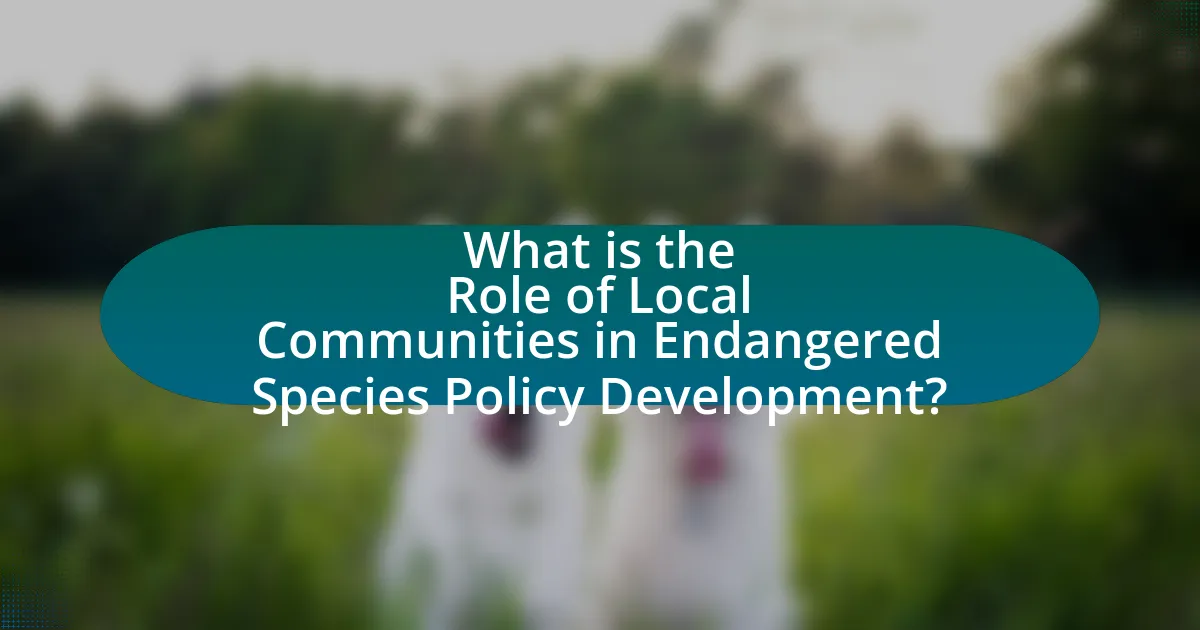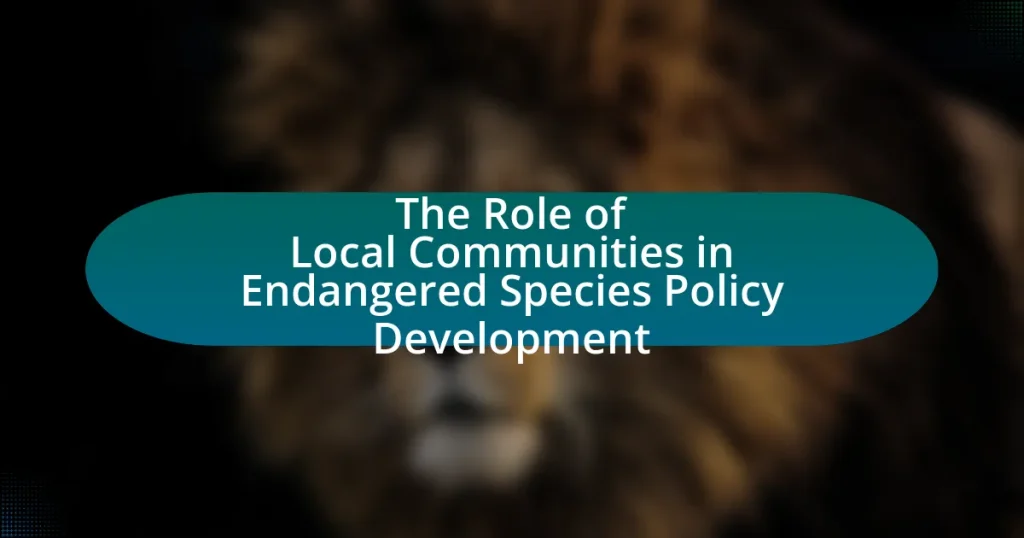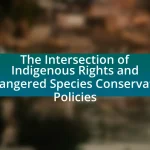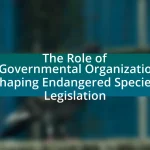Local communities are integral to the development of endangered species policies, as they provide essential local knowledge and foster effective conservation efforts. Their involvement leads to culturally relevant and practical policies that align with local ecological and socio-economic contexts. The article explores how local communities influence policy through grassroots advocacy, participation in decision-making, and the sharing of traditional ecological knowledge. It also addresses the challenges these communities face, such as limited resources and representation, while highlighting successful case studies that demonstrate the benefits of community engagement in conservation initiatives. Strategies for empowering local communities and best practices for integrating their perspectives into policy development are also discussed.

What is the Role of Local Communities in Endangered Species Policy Development?
Local communities play a crucial role in endangered species policy development by providing valuable local knowledge and fostering conservation efforts. Their involvement ensures that policies are culturally relevant and practically applicable, as local residents often have firsthand experience with the species and ecosystems in question. Studies, such as those published in the journal “Conservation Biology,” demonstrate that community-based conservation initiatives can lead to more effective management of endangered species, as they align conservation goals with local needs and practices. This collaboration enhances the likelihood of successful policy implementation and long-term sustainability of conservation efforts.
How do local communities influence endangered species policies?
Local communities influence endangered species policies through grassroots advocacy, local knowledge, and participation in decision-making processes. Their involvement often leads to more effective conservation strategies that reflect the specific ecological and cultural contexts of the area. For instance, community-led initiatives in regions like the Amazon rainforest have demonstrated that local stewardship can enhance biodiversity protection while also addressing socio-economic needs. Research shows that policies incorporating local input tend to have higher compliance rates and better outcomes for species conservation, as evidenced by the success of community-based conservation programs in places like Namibia, where local communities manage wildlife resources effectively.
What mechanisms allow local communities to participate in policy development?
Local communities can participate in policy development through mechanisms such as public consultations, stakeholder engagement processes, and collaborative governance frameworks. Public consultations allow community members to voice their opinions and provide input on proposed policies, ensuring that local knowledge and concerns are considered. Stakeholder engagement processes involve identifying and involving relevant community representatives in discussions, which fosters a sense of ownership and accountability. Collaborative governance frameworks, such as co-management agreements, enable local communities to share decision-making power with governmental and non-governmental organizations, leading to more inclusive and effective policy outcomes. These mechanisms have been shown to enhance the relevance and acceptance of policies, particularly in the context of endangered species management, as evidenced by case studies where local involvement has led to successful conservation efforts.
How do local knowledge and practices contribute to policy effectiveness?
Local knowledge and practices enhance policy effectiveness by providing context-specific insights that inform decision-making. This localized understanding allows policymakers to tailor strategies that align with community needs and ecological realities, leading to more sustainable outcomes. For instance, research conducted by Berkes (2009) in “Evolution of Co-management: Role of Local Knowledge” highlights how indigenous practices in resource management have led to improved conservation efforts, demonstrating that integrating local knowledge can result in policies that are more relevant and accepted by the community.
Why is community involvement crucial in endangered species conservation?
Community involvement is crucial in endangered species conservation because it fosters local stewardship and enhances the effectiveness of conservation efforts. When communities actively participate, they contribute valuable local knowledge and resources, which can lead to more tailored and sustainable conservation strategies. Research indicates that conservation initiatives that engage local populations are more likely to succeed; for example, a study published in the journal “Conservation Biology” found that community-led projects in Madagascar resulted in a 30% increase in biodiversity compared to top-down approaches. This evidence underscores the importance of integrating community perspectives and practices into conservation policies to achieve meaningful and lasting outcomes.
What are the benefits of including local communities in policy-making?
Including local communities in policy-making enhances the effectiveness and sustainability of policies, particularly in the context of endangered species. Local communities possess unique knowledge about their environment and the species within it, which can lead to more informed decision-making. For instance, research by the International Union for Conservation of Nature (IUCN) indicates that community-led conservation initiatives often result in higher success rates for biodiversity preservation compared to top-down approaches. Furthermore, involving local stakeholders fosters a sense of ownership and responsibility, increasing compliance with conservation measures. This participatory approach can also improve social equity, as it ensures that the voices of those most affected by policies are heard and considered.
How does community engagement enhance conservation outcomes?
Community engagement enhances conservation outcomes by fostering local stewardship and increasing compliance with conservation initiatives. When communities are actively involved in conservation efforts, they develop a sense of ownership and responsibility towards local ecosystems, which leads to more effective protection and sustainable management of natural resources. Research indicates that projects incorporating local knowledge and participation, such as the “Community-Based Conservation” model, have shown higher success rates in biodiversity preservation compared to top-down approaches. For instance, a study published in the journal “Conservation Biology” found that community-led initiatives in Madagascar resulted in a 50% increase in forest cover over a decade, demonstrating the tangible benefits of engaging local populations in conservation efforts.

What challenges do local communities face in policy development?
Local communities face significant challenges in policy development, particularly in the context of endangered species. These challenges include limited access to resources, insufficient representation in decision-making processes, and a lack of technical expertise. For instance, many local communities may not have the financial means to engage in comprehensive research or advocacy efforts, which can hinder their ability to influence policy effectively. Additionally, when local voices are underrepresented in governmental or organizational discussions, policies may not reflect the unique needs and knowledge of these communities, leading to ineffective or inappropriate conservation strategies. Furthermore, the complexity of environmental regulations often requires specialized knowledge that local stakeholders may lack, making it difficult for them to participate fully in policy formulation.
What barriers hinder local community participation in endangered species policies?
Barriers that hinder local community participation in endangered species policies include lack of awareness, insufficient resources, and limited access to decision-making processes. Many community members are unaware of the policies or the importance of their involvement, which reduces engagement. Additionally, communities often lack the financial and technical resources necessary to participate effectively, leading to a disconnect between policymakers and local stakeholders. Furthermore, when decision-making processes are centralized and exclude local voices, it diminishes the potential for meaningful participation. Studies have shown that inclusive policies that actively engage local communities lead to more effective conservation outcomes, highlighting the importance of addressing these barriers.
How do socio-economic factors impact community involvement?
Socio-economic factors significantly impact community involvement by influencing individuals’ resources, access to information, and motivation to participate in local initiatives. Communities with higher income levels often have more access to education and resources, which can lead to greater awareness and engagement in policy development, including endangered species initiatives. For instance, a study by the World Bank found that communities with better economic conditions are more likely to participate in conservation efforts, as they can allocate time and resources to such activities. Conversely, lower socio-economic status can limit participation due to financial constraints, lack of education, and reduced access to information, thereby diminishing the community’s ability to engage effectively in policy discussions and actions related to endangered species.
What role does governance play in facilitating or obstructing participation?
Governance plays a critical role in either facilitating or obstructing participation in the context of local communities involved in endangered species policy development. Effective governance structures, characterized by transparency, inclusivity, and accountability, promote active engagement from local communities, enabling them to contribute valuable insights and traditional knowledge essential for policy formulation. For instance, participatory governance models, such as those implemented in community-based conservation initiatives, have shown increased local involvement and improved conservation outcomes, as evidenced by the success of the Ngorongoro Conservation Area in Tanzania, where local input significantly shaped management strategies.
Conversely, poor governance can obstruct participation by creating barriers such as bureaucratic red tape, lack of communication, and exclusionary practices that marginalize community voices. Research indicates that in regions where governance is centralized and non-inclusive, local communities often feel disenfranchised, leading to resistance against conservation policies. A study by the International Union for Conservation of Nature highlights that effective governance frameworks that engage local stakeholders lead to higher compliance and better conservation results, underscoring the importance of governance in facilitating participation.
How can these challenges be addressed?
Local communities can address challenges in endangered species policy development by actively participating in decision-making processes and collaborating with conservation organizations. Engaging local stakeholders ensures that policies reflect the needs and knowledge of those directly affected by conservation efforts. For example, the involvement of indigenous communities in the management of natural resources has been shown to enhance biodiversity outcomes, as evidenced by the success of community-led conservation initiatives in places like the Amazon rainforest. Additionally, providing education and resources to local communities empowers them to implement sustainable practices that protect endangered species while also supporting their livelihoods.
What strategies can empower local communities in policy development?
Local communities can be empowered in policy development through inclusive participation, capacity building, and collaboration with stakeholders. Inclusive participation ensures that community members have a voice in decision-making processes, which can lead to policies that reflect their needs and values. Capacity building involves providing training and resources to enhance the skills and knowledge of community members, enabling them to engage effectively in policy discussions. Collaboration with stakeholders, including government agencies and NGOs, fosters partnerships that can amplify community perspectives and facilitate access to necessary resources. Evidence from the Convention on Biological Diversity highlights that local involvement in conservation policies leads to more sustainable outcomes, as seen in successful community-led initiatives in various regions.
How can collaboration between stakeholders improve outcomes?
Collaboration between stakeholders can improve outcomes by fostering diverse perspectives and shared resources, leading to more effective decision-making in endangered species policy development. When local communities, government agencies, and conservation organizations work together, they can leverage local knowledge and expertise, which enhances the understanding of species needs and habitat conditions. For instance, a study published in the journal “Conservation Biology” by Bertram and Vivier (2018) demonstrated that collaborative approaches in conservation efforts resulted in a 30% increase in the effectiveness of species recovery plans compared to isolated efforts. This evidence underscores that stakeholder collaboration not only enriches the policy-making process but also leads to measurable improvements in conservation outcomes.

What are the best practices for integrating local communities into endangered species policy development?
The best practices for integrating local communities into endangered species policy development include fostering participatory governance, ensuring transparent communication, and providing capacity-building opportunities. Participatory governance allows local communities to actively engage in decision-making processes, which has been shown to enhance the effectiveness of conservation efforts. For example, the International Union for Conservation of Nature (IUCN) emphasizes that involving local stakeholders leads to more sustainable outcomes. Transparent communication ensures that community members are informed about policies and their implications, which builds trust and encourages collaboration. Additionally, providing training and resources empowers communities to contribute effectively to conservation initiatives, as evidenced by successful programs in regions like the Amazon, where local knowledge has significantly improved biodiversity management.
What successful case studies exist that highlight community involvement?
Successful case studies that highlight community involvement include the recovery of the California condor and the conservation efforts for the red-cockaded woodpecker. In the California condor case, local communities engaged in habitat restoration and educational programs, leading to a population increase from 27 individuals in 1987 to over 500 today. This collaborative effort involved partnerships between the U.S. Fish and Wildlife Service, local tribes, and conservation organizations, demonstrating effective community engagement in species recovery.
Similarly, the red-cockaded woodpecker’s recovery involved local landowners and forestry companies in the Southeast U.S. Through the implementation of habitat management practices that benefited both the species and the timber industry, the population grew from 2,000 pairs in the 1970s to approximately 10,000 pairs today. This case illustrates how community involvement in land management can lead to successful conservation outcomes.
How did these case studies achieve effective policy outcomes?
These case studies achieved effective policy outcomes by actively involving local communities in the decision-making process. Engaging local stakeholders ensured that policies were tailored to the specific ecological and social contexts of the areas affected, leading to greater acceptance and compliance. For instance, in the case of the recovery of the California condor, local community involvement in habitat restoration efforts resulted in a significant increase in the species’ population, demonstrating the effectiveness of collaborative approaches in policy implementation.
What lessons can be learned from these examples?
Lessons learned from examples of local communities in endangered species policy development include the importance of community engagement and collaboration. Engaging local communities fosters a sense of ownership and responsibility towards conservation efforts, leading to more effective policy outcomes. For instance, studies show that when local stakeholders are involved in decision-making, conservation initiatives are more likely to succeed, as evidenced by the success of community-led conservation projects in places like Namibia, where local involvement has led to significant increases in wildlife populations. Additionally, these examples highlight the necessity of integrating traditional ecological knowledge with scientific research, which enhances the effectiveness of conservation strategies.
What practical steps can local communities take to engage in policy development?
Local communities can engage in policy development by forming coalitions to advocate for endangered species protection. These coalitions can conduct research to gather data on local species and ecosystems, which provides a factual basis for policy proposals. Additionally, communities can organize public forums to discuss conservation issues, allowing residents to voice their concerns and ideas, thereby fostering a collaborative environment. Engaging with local government officials through meetings and presentations can also influence policy decisions, as demonstrated by the success of community-led initiatives in various regions. For instance, the community-driven efforts in the Pacific Northwest have led to the implementation of policies that protect salmon habitats, showcasing the effectiveness of local involvement in policy development.
How can communities build partnerships with conservation organizations?
Communities can build partnerships with conservation organizations by actively engaging in collaborative projects that align with conservation goals. This can include organizing local conservation initiatives, participating in habitat restoration efforts, and sharing traditional ecological knowledge that enhances conservation strategies. For instance, the partnership between the San Juan Islands Conservation District and local communities in Washington State has successfully led to the restoration of critical habitats, demonstrating the effectiveness of community involvement in conservation efforts. Such collaborations not only strengthen conservation outcomes but also empower communities by fostering a sense of ownership and responsibility towards local ecosystems.
What resources are available to support community-led initiatives?
Community-led initiatives can be supported through various resources, including funding opportunities, training programs, and collaborative networks. Funding sources such as grants from government agencies, non-profit organizations, and foundations specifically target community projects aimed at conservation and policy development. Training programs offered by environmental organizations equip community members with skills in project management, advocacy, and species conservation. Collaborative networks, such as local conservation groups and online platforms, facilitate knowledge sharing and partnership building among communities, enhancing their capacity to engage in endangered species policy development.


